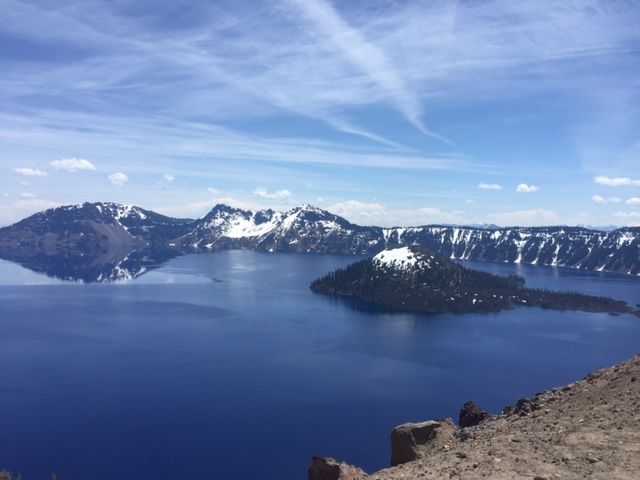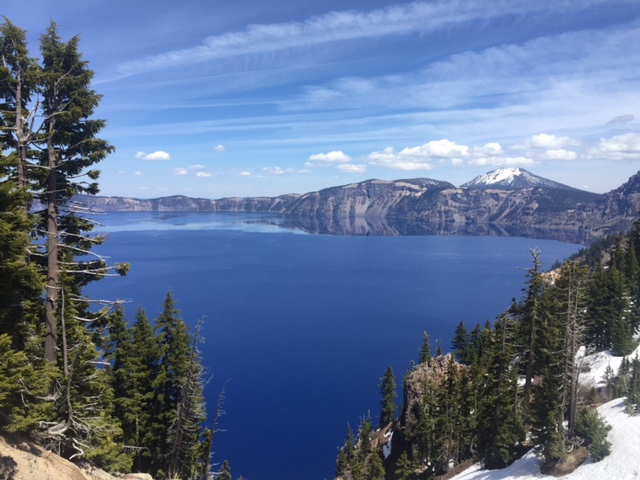A Lake Like No Other
Crater Lake, Oregon
With the Photo Challenge winding down, Marisa mentioned to me that she was out of town but she did not mention that she was at THIS place – only when the photos came in days later was I in the know. She writes:
Here’s two pictures for the photo challenge- Crater Lake, Oregon.
And here is more from Marisa:
I was actually in Grants Pass, Oregon visiting my father-in-law who turned 80 on the 23rd. To get back to Eugene where we were flying out of, we took a detour to see Diamond Lake and Crater Lake. It was 58 degrees at 7500 feet. Snow was on the ground and about 8′ in some areas along the road.
About Crater Lake (courtesy of the National Park Service)
How much snow does the park get and does it ever go away?
The average snowfall at Crater Lake is 533 inches every year. That’s about 44 feet. The greatest cumulative snowfall for one season was 879 inches (73 feet) the winter of 1932-33. The greatest depth on the ground at one time was 258 inches (21½ feet) the winter of 1983. Most of the snow usually melts by the beginning of August, although after particularly heavy seasons, there are drifts that fail to melt before the snows return again in the early Fall.
How deep is the lake?
Crater Lake is 1,943 feet deep. That makes it the deepest lake in the United States, and the ninth deepest lake in the world!
Does the lake ever freeze?
Very Rarely. Our weather systems generally come off the Pacific Ocean. Though this means a great deal of precipitation (usually snow,) oceans are a moderating force for temperature meaning it rarely gets cold enough to freeze so much water. The last complete surface freeze was in 1949. A 95% freeze occurred in 1985.
Where can I get to the lake to go swimming?
There is only one place where it is safe and legal to get down to the lake shore. It is the Cleetwood Cove Trail, which usually opens mid to late June. The trail is 1.1 miles long and drops nearly 700 feet down to the lake shore. Visitors are welcome to swim in the lake from the shoreline at the end of this trail.
Are there any fish in the lake? Where can I go fishing?
Fish are not native to the lake. They were introduced in the lake from 1888-1941. Six species were originally stocked, but only two have survived to today: Rainbow Trout and Kokanee Salmon. Because they are not native to the lake, fishing is not only allowed, it’s encouraged. No license is required and there is no limit on how many you may catch – the only rule is that you must use artificial bait. We don’t want to accidentally introduce any other species into the lake. Fishing is allowed along the shoreline and on Wizard Island (with the purchase of a boat tour and Wizard Island ticket.)
Did they ever find the meteor that made the crater?
This is not a meteor crater – a hole made by the impact of a big rock from space – so there is no meteor to find. Rather, this is a volcanic caldera – a hole made by the collapse of a volcano.
Was there a volcano here?
Yes, and there still is! For approximately 400,000 years, volcanic eruptions here built up a 10,000 – 12,000 foot mountain now called Mt. Mazama. 7,700 years ago, the volcano erupted in a cataclysmic eruption. During this eruption, so much material was evacuated from the internal magma chamber that afterwards, there was not enough left to support the remaining mountain. It collapsed and created the hole – the caldera – that we now see today half filled with water.
What kind of birds might I see?
Most common birds seen in the park: Raven, Clark’s Nutcracker, Gray Jay, Steller’s Jay, Dark-Eyed Junco, and Mountain Chickadee.
What kind of animals do you have at the park?
Most common: Roosevelt Elk, Mule Deer, Black Bear, Coyote, Bobcat, Porcupine, Yellow-bellied Marmot, Pine Marten, Snowshoe Hare, Pika, Golden-mantled Ground Squirrel, and Townsend Chipmunk.
Do you have eagles at the park?
Yes! Bald eagles are seen fairly often in the summer – especially from the boats. Golden Eagles are more rare, but usually make an appearance a couple times a year.
What do you put in the water to make it so blue?
Nothing! The water is so blue because there is hardly anything else in it – just water. It’s not pure water, but it’s close. We’ve all seen the colors in a rainbow when normal white light passes through a raindrop and breaks into the individual colors of the spectrum. All those colors are in sunlight. The reason different objects appear to be different colors lies in the molecular structure of the chemicals that make up that object. For example, a red shirt appears red because the chemicals in the fabric dye are put together in a way that absorbs all of the colors except red. The red wavelengths then bounce back, hit our retina, and our brain sees “red.” Water molecules, just plain water with no sediments, algae, pesticides or pollution, will absorb all the colors of the spectrum except the blues. Those wavelengths will bounce back and make the water appear blue. The key is to have relatively pure water and lots of it. There has to be enough molecules to absorb all the other colors. (There are 4.6 trillion gallons of water in the lake, so it works really well.)
What is the yellow stuff floating in the lake?
Through the month of June and into July, yellow swirls of “stuff” can be seen on the surface of the lake and will always prompt great concern from the visitors. It’s not pollution or oil or some sort of chemical foamy stuff, it’s merely pine pollen – the same stuff that most people find coating their cars in the spring. It’s harmless to the lake and will eventually settle out to the bottom.
How cold is the water?
The average temperature (below 300 feet deep) is 38°. In the summer, the surface can warm up to 55° or 60°.
(courtesy of the National Park Service)



I was actually in Grants Pass Oregon visiting my father in law who turned 80 on the 23rd. To get back to Eugene where we were flying out of, we took a detour to see Diamond Lake and Crater Lake. It was 58 degrees at 7500 feet. Snow was on the ground and about 8′ in some areas along the road.
Thank you for those breathtaking photos, and fascinating information about this amazing lake.
Fantastic picture and great information on Crater Lake.
Just amazing….